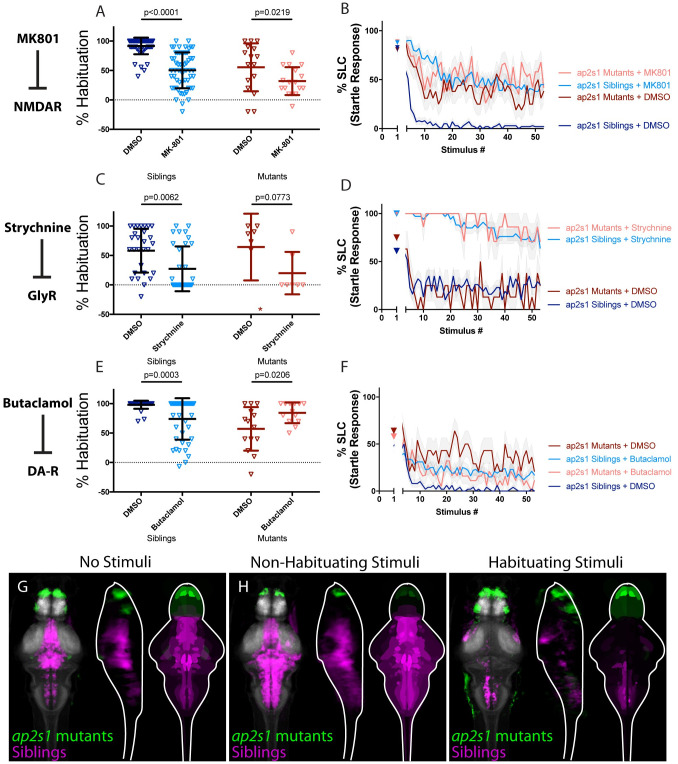Fig 6
(A-B) MK-801 significantly enhances habituation learning deficits observed in ap2s1 mutant larvae, indicating that NMDA signaling and ap2s1 may act within parallel molecular or circuit pathways to regulate habituation (p<0.0001, n = 54 DMSO Siblings, n = 58 MK-801 siblings; p = 0.0219, n = 16 DMSO mutants, n = 17 MK-801 mutants; p = 0.0875 indicates non-significant interaction between drug treatment and genotype). (C-D) Strychnine trends toward enhancing habituation learning deficits observed in ap2s1 mutant larvae (p = 0.0062, n = 29 DMSO siblings, n = 33 Strychnine siblings; p = 0.0773, n = 7 DMSO mutants, n = 7 Strychnine mutants; p = 0.5651 indicates non-significant interaction between drug treatment and genotype). Inspection of learning curves in (D) shows dramatic differences between vehicle and drug-treated larvae, indicating that glycine signaling and ap2s1 act within parallel molecular or circuit pathways to regulate habituation learning. *indicates a mutant+DMSO individual with a % hab value below y-axis limit at -60% (E-F) While Butaclamol inhibits habituation learning in siblings (p = 0.0003, n = 36 DMSO siblings, n = 42 Butaclamol siblings) it does not significantly enhance habituation learning deficits in ap2s1 mutant larvae. Rather, ap2s1 mutant animals learn significantly more robustly in the presence of the normally habituation-blocking Butaclamol (p = 0.0206, n = 14 DMSO mutants, n = 13 Butaclamol mutants; p<0.0001 indicates significant interaction between drug treatment and genotype). (G-I) Regions upregulated in ap2s1 mutants are indicated in green; regions downregulated in ap2s1 mutants are indicated in magenta. In all images, the left panel is a summed z-projection of the whole-brain activity changes. The middle panel is a summed x-projection of the whole brain activity changes. The right panel is a z-projection of the analyzed MAP-map. Consistent with the even stronger effect of Butaclamol in driving habituation learning in ap2s1 mutants relative to pappaa mutants, ap2s1 mutant animals exhibit an even more dramatically inverted pattern relative to Butaclamol-treated animals. ap2s1 mutant animals exhibit robust upregulation in the telencephalon (while Butaclamol-treated animals show downregulation here). Similarly, ap2s1 mutants show dramatically downregulated activity within the rhombencephalon, while our Butaclamol results indicate that dopamine inhibition upregulates activity here. See also S1–S3 Tables for ROIs up- and down-regulated in each condition, as well as in independent replicates.

